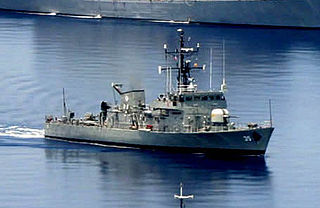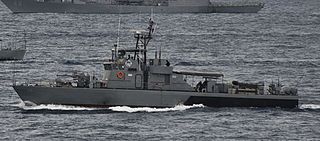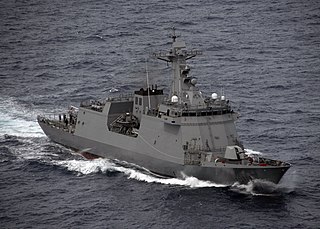
The Philippine Navy (PN) is the naval warfare service branch of the Armed Forces of the Philippines. It has an estimated strength of 24,500 active service personnel, including the 8,300-strong Philippine Marine Corps. It operates 80 combat ships, 13 auxiliary ships, 25 aircraft and 8 unmanned aerial vehicles. It shares the responsibility of patrolling the maritime borders with the Philippine Coast Guard, a formerly attached unit which became a separate maritime law enforcement agency in 1998.

BRP Benguet (LS-507) is a LST-542-class tank landing ship currently serving the Philippine Navy.

USS LST-821, renamed USS Harnett County (LST-821/AGP-281), was an LST-542-class tank landing ship built for the United States Navy during World War II. She was named for Harnett County, North Carolina and was the only U.S. Naval vessel to bear the name. She served the United States Navy in World War II and the Vietnam War. She was transferred to South Vietnam's Republic of Vietnam Navy, which named her RVNS My Tho (HQ-800).

The BRP Bacolod City (LS-550) is the lead ship of two Bacolod City class logistics support vessel, and is based on a helicopter capable variant of the US Army's Frank S. Besson class. She is also considered one of the most modern transport ships in the Philippine Navy, having been commissioned during the early 1990s. She was previously known as BRP Bacolod City (LC-550) prior to a classification change implemented by the Philippine Navy starting April 2016.

The BRP Rajah Humabon (PS-11) was a former destroyer escort of the United States Navy and a former frigate of the Philippine Navy. It was the last World War II-era destroyer escort/frigate active in its fleet, and one of the oldest active warships in the world, until 15 March 2018 when it was formally decommissioned after 75 years. She was one of three ex-USN Cannon-class destroyer escorts that served the Philippine Navy, the others being BRP Datu Sikatuna (PF-5/PS-77) and BRP Datu Kalantiaw (PS-76).

The BRP Quezon (PS-70) was one of two Rizal class ships in service with the Philippine Navy. She was formerly a USN Auk class minesweeper produced during World War II, and was later on classified as a patrol corvette protecting the vast waters of the Philippines.

The BRP Rizal (PS-74) was the lead ship and first of two Rizal class ships in service with the Philippine Navy. She was an ex-USN Auk class minesweeper that was produced during World War II, and was classified as a patrol corvette protecting the vast waters of the Philippines. Along with other ex-World War II veteran ships of the Philippine Navy, she was considered one of the oldest active fighting ships in the world, until 2020.

The BRP Emilio Jacinto (PS-35) is the lead ship of the Jacinto-class corvettes currently assigned to the Offshore Combat Force of the Philippine Fleet. She is one of few ships in the Philippine Navy equipped with modern systems after the completion of combat, navigation and weapon systems upgrade of her class in August 2019. She was originally called HMS Peacock (P239) during her service with the Royal Navy.

The BRP Tagbanua (LC-296) is a landing craft utility of the Philippine Navy. She was named after the Tagbanua tribe mainly residing in Palawan island. She is the largest Philippine-made naval vessel launched to date.
BRP Emilio Liwanag (PC-118) was a Tomas Batilo class fast attack craft of the Philippine Navy. It was part of the last batch of such craft transferred to the Philippines by the South Korean government in 2006. After 2 years of refurbishing, refitting and upgrade, the ship was commissioned into active service by the Philippine Navy on 15 April 2011, although it was presented to the public as early as May 2010 during the 112th Anniversary of the Philippine Navy.

BRP Salvador Abcede (PC-114) was a Tomas Batilo-class fast attack craft of the Philippine Navy. It was part of the first batch transferred by the South Korean government on 15 June 1995, and arrived in the Philippines in August 1995. It was commissioned with the Philippine Navy on 22 May 1996.

The Tomas Batilo class was a ship class of eight patrol boats that were previously service of the Philippine Navy. These ships were formerly used by the South Korean Navy as Chamsuri/Wildcat class fast attack crafts. All eight ships have been retired from active service, with two units lost in separate incidents while the rest are in different state of disposal.

Assault Craft Unit TWO (ACU-2) is an Atlantic Ocean Maritime Prepositioning Force in the United States Navy operated under Naval Beach Group Two out of Naval Amphibious Base Little Creek, Virginia. ACU-2's force consists of Landing Craft Utility boats (LCU), Landing Craft Mechanized, Mark 8 boats (LCM), and Maritime Prepositioning Force Utility Boats (MPFUB). The sister unit of ACU-2 is Assault Craft Unit 1 in Naval Amphibious Base Coronado.

The Tarlac class are landing platform docks of the Philippine Navy meant for amphibious operations and transport duties in support of the Armed Forces of the Philippines. The class was initially called the "Strategic Sealift Vessel" before being formally named. The ships will also double as a support platform for Humanitarian and Disaster Relief (HADR) and Search & Rescue (SAR) operations.

BRP Tarlac (LD-601) is the lead ship of her class of landing platform docks in service with the Philippine Navy. She is the second ship to be named after the Philippine province of Tarlac, one of the provinces considered to have significant involvement in the Philippine Revolution of independence against Spain.
The BRP Agta (LC-290) is a landing craft heavy of the Philippine Navy. From 1972 to 2012, it was known as HMAS Balikpapan (L 126) and served the Royal Australian Navy. It was decommissioned in December 2012, was stored until it was sold by the Australian government to the Philippine Navy to assist in improving the country's Humaritarian and Disaster Relief capabilities.

BRP Ramon Alcaraz (PS-16) is the second ship of the Gregorio del Pilar-class offshore patrol vessels of the Philippine Navy. From 1968 to 2012, she was known as USCGC Dallas and served the United States Coast Guard as a high endurance cutter. She was decommissioned on 30 March 2012 and acquired by the Philippines under the Excess Defense Articles and the Foreign Assistance Act.

The Jose Rizal-class of multi-role guided missile frigates, currently in service with the Philippine Navy, are a heavily modified variant of the ROK Navy's Incheon-class frigates. The ships, which were built by Hyundai Heavy Industries (HHI), are specifically accommodated to fit the requirements of the Philippine Navy. The frigates will improve the ability of the Philippine Navy's Offshore Combat Force, which is mostly composed of ships that were retired from other countries and subsequently transferred to the Philippines.

PT PAL Indonesia (Persero) ) is an Indonesian state-owned enterprise that manufactures ships for military and civilian use and conducts repairs and maintenance on ships and engineering.
















